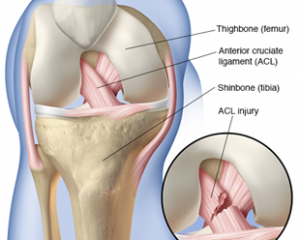ACL Injury (Tearing of Ligament in Knee): Causes, Symptoms & Amp; Its Treatment

An ACL injury is the tearing of the anterior cruciate ligament (ACL) one of the major ligaments in the knee. ACL injuries most commonly occur during sports that involve sudden stops, jumping, or changes in direction such as basketball, soccer, football, tennis, downhill skiing, volleyball, and gymnastics.
Many people hear or feel a “pop” in the knee when an ACL injury occurs. the knee may swell, feel unstable and become too painful to bear weight.
Causes
Ligaments are strong bands of tissue that connect one bone to another. The ACL, one of two ligaments that cross in the middle of the knee, connects the thighbone (femur) to the shinbone (tibia) and helps stabilize the knee joint.
Most ACL injuries happen during sports and fitness activities that can put stress on the knee:
- Suddenly slowing down and changing direction (cutting)
- Pivoting with your foot firmly planted
- Landing from a jump incorrectly
- Stopping suddenly
- Receiving a direct blow to the knee or collision, such as a football tackle
When the ligament is damaged, there is usually a partial or complete tear across the tissue. A mild injury may overextend the ligament but leave it intact
Symptoms
Signs and symptoms of an ACL injury usually include:
- A loud “pop” or a “popping” sensation in the knee
- Severe pain and inability to continue the activity
- Swelling that begins within a few hours
- Loss of range of motion
- A feeling of instability or “giving way” to weight-bearing
Complications
People who experience an ACL injury are at higher risk of developing knee osteoarthritis, in which joint cartilage deteriorates and its smooth surface roughens.
Prevention
Proper training and exercise can help reduce the risk of ACL injury. A physical therapist can provide assessment, instruction, and feedback that can help you reduce risks.
Programs to reduce ACL injury include:
- Exercises that strengthen leg muscles, particularly hamstring exercises, to ensure an overall balance in leg muscle strength
- Exercises to strengthen the core: hips, pelvis, and lower abdomen
- Training and exercise for proper techniques and knee position in jumping and landing
- Training to improve techniques for pivoting and cutting
Rehabilitation
The major goals of rehabilitation of the ACL-injured knee:
- Gain good functional stability
- Repair muscle strength
- Reach the best possible functional level
- Decrease the risk for re-injury
Closed kinetic chain exercise (CKC) and Open kinetic chain exercises (OKC) play an important role in regaining muscle (quadriceps, hamstrings) strength and knee stability.
Closed kinetic chain exercises have become more popular than Open kinetic chain exercises in ACL rehabilitation. Clinicians believe that CKC exercises are safer than OKC exercises because they place less strain on the ACL graft. Besides, they also believe that CKC exercises are more functional and equally effective as OKC exercises
General Considerations
Acute Stage
After ACL injury, regardless of whether surgery will take place or not, physiotherapy management focuses on regaining range of movement, strength, proprioception, and stability.
PRICE should be used in order to reduce swelling and pain, attempt full range of motion, and decrease joint effusion.
- Static quads/SLR
- Ankle DF/PF/circumduction
- Knee flexion/extension in sitting
- Patellar mobilisations
- Glute med work in side-lying
- Glute exercises in prone
- Knee flexion in prone (gentle kicking exercises)
Weight transfers in standing
- Also, consider taping to provide stability and encourage a reduction in swelling.
Before Surgery
Before proceeding with surgery, the acutely injured knee should be in a quiescent state with little or no swelling, have a full range of motion, and the patient should have a normal or near-normal gait pattern.
Important is to prepare the knee for the surgery. These are the guidelines:
- Immobilize the knee
- Control Pain and Swelling
- Restore normal range of motion
- Develop muscle strength
- Mentally prepare
After Surgery
- Regular icing and elevation are used to reduce swelling.
- The patient must try to genuinely increase the stance phase in an attempt to walk with one crutch.
- The use of the knee brace is progressively reduced.
- Forward, backward, and lateral dynamic movements can be included as well as isokinetic exercises.
- The final goal is to maximize the endurance and strength of the knee stabilizers,
- Knee isometrics
Check out these links for relevant information: Sports
physiotherapy

Progressive Care Physiotherapy
Progressive Care Physiotherapy Management is the best service in the physiotherapy industry. It is known for providing the best service and cutting-edge technology to help speed up recovery, while also being able to offer various treatment options that are tailored to your specific needs.
For More details call us on 9618906780
